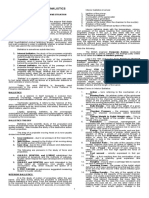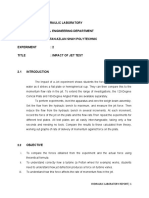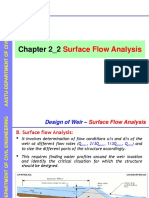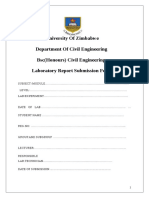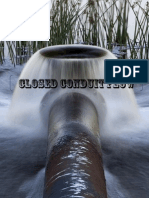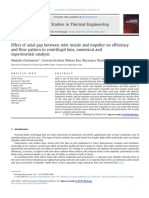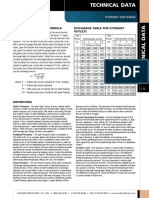Lab - #5. - Hydraulic Jump
Lab - #5. - Hydraulic Jump
Uploaded by
Carlos J. SantacruzCopyright:
Available Formats
Lab - #5. - Hydraulic Jump
Lab - #5. - Hydraulic Jump
Uploaded by
Carlos J. SantacruzOriginal Description:
Original Title
Copyright
Available Formats
Share this document
Did you find this document useful?
Is this content inappropriate?
Copyright:
Available Formats
Lab - #5. - Hydraulic Jump
Lab - #5. - Hydraulic Jump
Uploaded by
Carlos J. SantacruzCopyright:
Available Formats
UNIVERSIDAD SAN FRANCISCO DE QUITO
COLEGIO POLITÉCNICO
ICV-0385 INGENIERÍA CIVIL HIDRÁULICA
LABORATORIO #5: HYDRAULIC JUMP
OBJECTIVES:
To physically achieve a hydraulic jump in the lab flume experiment.
To measure the physical dimensions of a hydraulic jump.
Calculate the energy losses dissipated through a hydraulic jump.
Classify the stability of various hydraulic jumps according to their Froude Number.
APPARATUS REQUIRED:
Hydraulic Channel Flume Collecting tank
Sluice Gate Water Pump
Ruler/Measuring Tape Weight Balance
THEORY:
Hydraulic jump in open channels can be attributed to rapidly varied flow where a significant change
in velocity occurs from supercritical flow to subcritical flow. This fact may owe to the presence of some
structures obstructing the movement of flow in open channels. Undershot weir or gate is the most impressive
example for hydraulic jump formation in canals where the flow undergoes high velocity under gates with
upstream small depth and returns to a higher downstream conjugate depth away from the gate with lower
velocity. Froude number represents the clear impact of nonuniform flow velocity in open channels where
supercritical flow is obtained at Froude number greater than 1, whereas subcritical flow is indicated at Froude
number less than 1. The main advantage of hydraulic jump occurrence in canals is energy dissipation
downstream spillways where accumulation of water behind the gate is associated to the high flow velocity
which abruptly declines downstream gate and thus avoiding bed erosion and scour.
Further studies have been discussed to show the relationship between conjugate depth ratio, Froude
number and energy dissipated in the hydraulic jump. Mathematical models based on experimental studies
have currently revealed an attractive way to demonstrate the influence of various parameters on canal
performance. Moreover, such models provide a beneficially robust tool to ensure the obtained outcomes
and approach more accurate results.
DESCRIPTION:
When water flows down a steep surface such as a spillway and enters a relatively flat channel, the
result is a transition from rapid shallow flow to slower, deeper flow. Any abrupt transition from a lower-stage
supercritical flow to a higher-stage subcritical flow is referred to as a hydraulic jump. Figure 5.1 shows a
hydraulic jump.
Hydraulic jumps can occur wherever flow in a channel is very rapid, such as a steep channel
transitioning to a flat channel or flow discharging under a sluice gate into a channel. Hydraulic jumps can also
be induced at a point of rapid flow to reduce the high velocity and thus control erosion downstream. Typical
jump-inducing structures include stilling basins and energy dissipaters consisting of concrete blocks acting as
obstructions to the flow.
Laboratorio de Hidráulica - LAB #5 1
LABORATORIO #5
ICV-0385 HYDRAULIC JUMP HIDRÁULICA
Fig 5.1: Hydraulic Jump.
Hydraulic jumps can be weak or very pronounced depending on flow conditions. A classification of
different types of jumps according to the Froude number (NFr) of the incoming flow has been developed. The
value of NFr must be greater than 1.0 for a hydraulic jump to form. This is because hydraulic jumps always
occur when flow transitions from supercritical flow to subcritical flow. According to the classification, the
greater the value of NFr, the stronger is the hydraulic jump. The strongest jumps occur when NFr > 9.0. For
values of NFr between 1.0 and 9.0, the hydraulic jumps that form have various characteristics, including weak,
oscillating, and steady.
Fig 5.2: Classification of Hydraulic Jumps.
Typical features of a hydraulic jump are shown in Figure 5.2. Flow depth before the jump, Y1, is called
initial depth and the depth after the jump, Y2, is called sequent depth. The length, L, of the jump cannot be
computed mathematically because of the complex motion of the water within the jump. However, values of
L have been determined experimentally and can be found in many hydraulic texts.
Laboratorio de Hidráulica - LAB #5 2
LABORATORIO #5
ICV-0385 HYDRAULIC JUMP HIDRÁULICA
Generally, sequent depth is determined by normal depth in the channel downstream of the hydraulic
jump. The location of the jump is determined by the initial velocity and the initial depth relative to the
sequent depth. A hydraulic jump will form in a rectangular channel when the following equation is satisfied:
1 2
𝑦2 = 𝑦 [ √1 + 8 𝑁𝐹1 −1]
2 1
The location of a hydraulic jump can be very important in the design of hydraulic structures. In the
case of a spillway, the apron would be extended downstream of the hydraulic jump to protect against scour.
Generally, if the sequent depth is increased, the jump occurs more upstream, and if the sequent
depth is decreased, the jump occurs more downstream. Usually, an upstream jump location is desirable.
However, control of the sequent depth is difficult because varying discharge values result in varying sequent
depths and therefore varying locations of the hydraulic jump. Methods of mitigating this problem include
constructing a stilling basin or a sloping apron.
FORMULAS USED:
A) HYDRAULIC JUMP
Sequent Depth (Y2) Flow Velocity (v)
1 2
𝑄
𝑦2 = 𝑦 [ √1 + 8 𝑁𝐹1 −1] 𝑣1 =
2 1 𝐵 𝑦1
Froude’s Number (NF) Height of Hydraulic Jump (y)
𝑣 ∆𝑦 = 𝑦2 − 𝑦1
𝑁𝐹 =
√𝑔 𝑦ℎ
B) SPECIFIC ENERGY
Specific Energy (E) Energy Dissipation (E)
𝑣2 (𝑦2 − 𝑦1 )3
𝐸 =𝑦+ ∆𝐸 = 𝐸1 − 𝐸2 =
2𝑔 4 𝑦1 𝑦2
Where,
Fig 5.3: Specific Energy of Hydraulic Jumps.
Laboratorio de Hidráulica - LAB #5 3
LABORATORIO #5
ICV-0385 HYDRAULIC JUMP HIDRÁULICA
PRECAUTIONS:
Check that air is not trapped in the hose or pump before turning it on.
Hydraulic jumps are very unstable so try to perform measurements accurately and quickly as possible.
Use 3 decimal digits for measurements values.
PROCEDURE (LAB INSTRUCTIONS):
Experiment steps:
1. Measure the width of the channel.
2. Start the pump to supply water to the flume and reach a steady state.
3. Then close the upstream gate to allow water to accumulate.
4. Develop the hydraulic jump by opening the sluice gate about 2 mm - 4 mm.
5. Adjust the position of the hydraulic jump by adjusting the amount of closure of sluice gate.
6. Measure the water surface level before the hydraulic jump.
7. Next, measure the water surface level downstream of the jump.
8. Repeated the measurement steps again for a different flowchart.
9. Estimate the flow velocity in the supercritical region and subcritical region by dividing the flow by the
area of each region.
After entering the readings in the Tabulation 5.1, compute the necessary values.
PROCEDURE (Write down your own procedure report format)
POST-EXPERIMENT ACTIVITIES:
The apparatus should be drained and cleaned after use.
Laboratorio de Hidráulica - LAB #5 4
LABORATORIO #5
ICV-0385 HYDRAULIC JUMP HIDRÁULICA
OBSERVATION AND COMPUTATIONS: Nombre: _____________________________
Canal Width B = __________________. Fecha: _________________
Tabulation 5.1: Hydraulic Jump data and Specific Energy calculations.
FLOW UPSTREAM OF FLOW DOWNSTREAM OF
Calculated HYDRAULIC JUMP
HYDRAULIC JUMP HYDRAULIC JUMP
Error
Run Volume Time Flow Y1 A1 v1 E1 Y2 A2 v2 E2 Y2* Y E
Error
NF1 NF2
(J/N)
Y2* Ecalc* Ecalc*
# (mL) (sec) (L/s) (mm) (cm2) (m/s) (J/N) (mm) (cm2) (m/s) (mm) (%)
= Y2-Y1 = E1-E2 (%)
Laboratorio de Hidráulica - LAB #5 5
LABORATORIO #5
ICV-0385 HYDRAULIC JUMP HIDRÁULICA
RESULTS AND COMMENTS:
1. Compute the velocity before and after the jump.
2. Compute the specific energy for each depth using the measured values of supercritical, Y1, and subcritical,
Y2, depths.
3. For each depth measured, compute the corresponding Froude number before and after the jump.
4. For the constant flowrate, compute the critical depth, Yc, using equation for critical flow conditions.
5. For each jump, compute the sequent depth, Y2*, for each measured value of Y1; and compare it with your
measurement of Y2, find % error.
6. Estimate the energy loss in the jump as the difference of E1–E2 and compare this value with E of the
equation, find % error.
7. Analyze and explain the results and calculations obtained from your lab experiment.
GRAPH:
Plot a Specific Energy curve diagram for 4 runs of your laboratory data. Show all pertinent depths (Y1, Y2,
Y2*, and Yc) and indicate the energy loss, , for each hydraulic jump (similar to Fig. 5.3).
Graphically, determine the alternate depth (Y2-alternate) for the initial specific energy E1.
Plot Froude’s Number NF1 vs Flow Depth Y1, taking Froude number on the y-axis and depth on the x-axis.
DISCUSSION:
Discuss assumptions of the theory applied and if any assumptions made caused a bias in this lab practice.
Discuss the accuracy of each result, numerically. Identify the possible experimental errors.
Analyze probable sources of error. Explain causes of the error and how much % on consequence.
Determine the %-Error between Y2-measured vs. Y2-calculated. Discuss the factors causing
discrepancy between Y2 measured vs. Y2 calculated.
Determine the %-Error between E vs. Ecalculated. Discuss the factors causing discrepancy between E
vs. Ecalculated.
QUESTIONS:
1) Why do we need to understand and analyze the behavior of a hydraulic jump? What is the purpose of a
hydraulic jump and where do you use them in the practical life?
2) What can you infer about the stability of each jump based on the computed sequent depth and the
laboratory data? Classify each jump based on their Froude Number.
3) Determine the Efficiency of each hydraulic jump based on the following equation:
(𝟖𝑵𝑭𝟏 𝟐 + 𝟏)𝟑/𝟐 − 𝟒𝑵𝑭𝟏 𝟐 + 𝟏
𝒆𝑱 = × 𝟏𝟎𝟎
𝟖𝑵𝑭𝟏 𝟐 (𝟐 + 𝑵𝑭𝟏 𝟐 )
4) What is the meaning of Froude Number? Explain the interpretation of this dimensionless parameter.
5) What is the difference between subsequent depth and alternate depth in a hydraulic jump?
Laboratorio de Hidráulica - LAB #5 6
You might also like
- Cheat Sheet - Fluids ExamDocument1 pageCheat Sheet - Fluids ExamadehdNo ratings yet
- Review Notes in CriminalisticsDocument97 pagesReview Notes in Criminalisticscriminologyalliance67% (3)
- De - Referral Hydraulics Lab Sheet Cousework - 2020-21yrDocument14 pagesDe - Referral Hydraulics Lab Sheet Cousework - 2020-21yrM ShakirNo ratings yet
- Experiment 7 DiagramDocument7 pagesExperiment 7 Diagramartemio john claveNo ratings yet
- V-Notch ExperimentDocument5 pagesV-Notch ExperimentKheshav Jhundoo100% (3)
- Shortcut Nitrogen Removal-Nitrite Shunt and DeammonificationFrom EverandShortcut Nitrogen Removal-Nitrite Shunt and DeammonificationNo ratings yet
- Open Channel Flow Report Lab PDF FreeDocument16 pagesOpen Channel Flow Report Lab PDF FreelucaggNo ratings yet
- To Study The Characteristics of The Hydraulic Jump Developed in Lab Flume.Document6 pagesTo Study The Characteristics of The Hydraulic Jump Developed in Lab Flume.Afzal WaseemNo ratings yet
- Hydraulic Laboratory Civil Engineering Department Sultan Azlan Shah Polytechnic Experiment: 2 Title: Impact of Jet TestDocument8 pagesHydraulic Laboratory Civil Engineering Department Sultan Azlan Shah Polytechnic Experiment: 2 Title: Impact of Jet TestAzrol Azmir Long100% (3)
- Hydraulic JumpDocument17 pagesHydraulic JumpSuhaimi SamNo ratings yet
- Hydraulics JumpDocument10 pagesHydraulics JumpIkhwan Z.100% (2)
- Broad Crested Weir Module-3Document4 pagesBroad Crested Weir Module-3Arvin Bhurtun100% (1)
- Report Hydraulic JumpsDocument11 pagesReport Hydraulic JumpsMayLeongNo ratings yet
- Hydraulics and Irrigation Engineering Lab Manual UpdatedDocument37 pagesHydraulics and Irrigation Engineering Lab Manual UpdatedKamalnath GNo ratings yet
- Lab-2: Flow Over A Weir Objectives: Water Resources Engineering Jagadish Torlapati, PHD Spring 2017Document4 pagesLab-2: Flow Over A Weir Objectives: Water Resources Engineering Jagadish Torlapati, PHD Spring 2017Katy PerryNo ratings yet
- Venturi Meter Experiment ProceduresDocument2 pagesVenturi Meter Experiment ProceduresAnonymous mRBbdopMKf100% (1)
- Lab Manual 2 Rectangular and Triangular NotchesDocument8 pagesLab Manual 2 Rectangular and Triangular NotchesLeo KhanNo ratings yet
- 02 - 2 Design of Weir - Surface AnalysisDocument84 pages02 - 2 Design of Weir - Surface AnalysisMohammed JemalNo ratings yet
- CE458 Chapter 5Document72 pagesCE458 Chapter 5Mihai MihailescuNo ratings yet
- Broad Crested Weir at OauDocument10 pagesBroad Crested Weir at OauEmmanuelNo ratings yet
- Hydraulic JumpDocument9 pagesHydraulic JumpAhmed Gamal100% (1)
- Hydraulic Laboratory Civil Engineering Department Sultan Azlan Shah PolytechnicDocument12 pagesHydraulic Laboratory Civil Engineering Department Sultan Azlan Shah PolytechnicSyafiq Roslan75% (4)
- The Broad Crested WeirDocument6 pagesThe Broad Crested WeirIshara CoorayNo ratings yet
- MEC2404 Frictional Flow in Pipe Lab RepoDocument10 pagesMEC2404 Frictional Flow in Pipe Lab Repoatik100% (1)
- About Chute SpillwayDocument15 pagesAbout Chute SpillwayPrem Singh RawatNo ratings yet
- Unsteady FlowDocument12 pagesUnsteady FlowGangaram SapkotaNo ratings yet
- Lab Report 2Document17 pagesLab Report 2Limmy Yingran100% (1)
- Fluid Mech Orifice 3Document9 pagesFluid Mech Orifice 3TatendaNo ratings yet
- Hydraulic Lab Manual 2017Document48 pagesHydraulic Lab Manual 2017Muhammad AdilNo ratings yet
- Sluice GateDocument6 pagesSluice GateCHEL TAKNo ratings yet
- 10.flow Over WeirDocument12 pages10.flow Over WeirHafizNotey100% (1)
- To Estimate Manning's Roughness Coefficient (N) and Chezy's Coefficient (C) For Open Channel Flow.Document6 pagesTo Estimate Manning's Roughness Coefficient (N) and Chezy's Coefficient (C) For Open Channel Flow.Shaheer AhmadNo ratings yet
- Manning's Roughness Coefficient (N)Document11 pagesManning's Roughness Coefficient (N)Khurram MumtazNo ratings yet
- CVNG 2003-Design II Culvert DesignDocument69 pagesCVNG 2003-Design II Culvert Designrajal11No ratings yet
- Pipe Friction ApparatusDocument6 pagesPipe Friction ApparatusShubham MauryaNo ratings yet
- Impact of JetDocument8 pagesImpact of JetOmar Faruqi100% (1)
- Cavitation Characteristics and Infinite Aspect Ration Characteristics of A Hydrofoil SectionDocument31 pagesCavitation Characteristics and Infinite Aspect Ration Characteristics of A Hydrofoil SectionMuadz MuhammadNo ratings yet
- Hydraulic Exp1Document15 pagesHydraulic Exp1FikrilAzimAbdulSaniNo ratings yet
- Closed Conduit Flow ExptDocument99 pagesClosed Conduit Flow ExptStephanie Anne FortinNo ratings yet
- Water-Resources Engineering - Parte 6Document50 pagesWater-Resources Engineering - Parte 6Jose Suarez100% (1)
- Sharp Crested WeirDocument4 pagesSharp Crested WeirRamizah AhmadNo ratings yet
- Chapter 1. Flow in Open Channel: Tan Lai Wai, Wan Afnizan & Zarina MD Ali Laiwai@uthm - Edu.my Updated: September 2014Document41 pagesChapter 1. Flow in Open Channel: Tan Lai Wai, Wan Afnizan & Zarina MD Ali Laiwai@uthm - Edu.my Updated: September 2014aliNo ratings yet
- Open Channel WeirsDocument19 pagesOpen Channel WeirsSudharsananPRSNo ratings yet
- Ahe QBDocument20 pagesAhe QBNivedhitha CNo ratings yet
- Hydraulics Module, Holistic Module at JJUDocument211 pagesHydraulics Module, Holistic Module at JJUmulerNo ratings yet
- Hydraulic JumpDocument28 pagesHydraulic JumpRyan HiraniNo ratings yet
- Lecture Notes 07Document39 pagesLecture Notes 07reem.ranoom.moon100% (2)
- CE 233 FM Lab Fall 2019 Lab ManualDocument42 pagesCE 233 FM Lab Fall 2019 Lab ManualRavi RajNo ratings yet
- Lecture 01b - Reservoirs (Part 2)Document59 pagesLecture 01b - Reservoirs (Part 2)Cj GumiranNo ratings yet
- Lecture # 01. Introduction, Water Resources, & Irrigation.Document64 pagesLecture # 01. Introduction, Water Resources, & Irrigation.Muhammad UsmanNo ratings yet
- Fluids Lab - Experiment 4 - Impact of A Jet of WaterDocument9 pagesFluids Lab - Experiment 4 - Impact of A Jet of WaterJordan Hines50% (2)
- Time To Empty TanksDocument32 pagesTime To Empty Tankstimothyatambo383No ratings yet
- Chapter Six Urban Hydrology 6. Urban Hydrology: Engineering Hydrology Lecture NoteDocument8 pagesChapter Six Urban Hydrology 6. Urban Hydrology: Engineering Hydrology Lecture NoteKefene GurmessaNo ratings yet
- Impact of JetDocument7 pagesImpact of JetHeng Xiu KohNo ratings yet
- Reynold Number Experiment ReportDocument5 pagesReynold Number Experiment Reportyolandaputriyud4825No ratings yet
- Design of Small DamsDocument5 pagesDesign of Small DamsNarendra Singh BhandariNo ratings yet
- Experiment 1 - Friction Losses in PipesDocument34 pagesExperiment 1 - Friction Losses in PipesKhairil Ikram33% (3)
- Weirs For Flow Measurement Lecture NotesDocument12 pagesWeirs For Flow Measurement Lecture NotesBacok Damora SaputraNo ratings yet
- Level HE6: RAS AL Khaimah CampusDocument6 pagesLevel HE6: RAS AL Khaimah CampusUmer RaufNo ratings yet
- Ecohydrology: Vegetation Function, Water and Resource ManagementFrom EverandEcohydrology: Vegetation Function, Water and Resource ManagementNo ratings yet
- Municipal Wastewater Treatment: Evaluating Improvements in National Water QualityFrom EverandMunicipal Wastewater Treatment: Evaluating Improvements in National Water QualityNo ratings yet
- Motion in AVerticle CircleDocument14 pagesMotion in AVerticle CircleAnil KumarNo ratings yet
- Wind Tunnel Experiments Procedure in UPMDocument5 pagesWind Tunnel Experiments Procedure in UPMMohd AnuarNo ratings yet
- Hydraulics Lecture 2 Part 2Document10 pagesHydraulics Lecture 2 Part 2Desiree RobisoNo ratings yet
- Determination of Blockage Correction in Open-Jet Wind TunnelDocument6 pagesDetermination of Blockage Correction in Open-Jet Wind Tunnelmoro1381100% (1)
- Test Series NEET - 2017 Elasticity & Fluid DynamicsDocument4 pagesTest Series NEET - 2017 Elasticity & Fluid Dynamicsumved singh yadavNo ratings yet
- Unit Ii Convection: Lower Temp Higher Temp 2 2 2Document26 pagesUnit Ii Convection: Lower Temp Higher Temp 2 2 2ASHISH K.K.No ratings yet
- Numerical Experiments in Turbulent Natural Convection Using Two-Equation Eddy-Viscosity ModelsDocument11 pagesNumerical Experiments in Turbulent Natural Convection Using Two-Equation Eddy-Viscosity Modelssattar aljabairNo ratings yet
- Free FallDocument19 pagesFree FallHaniyah LazimNo ratings yet
- Influence of Porosity of Reformed Earth Embankment Windbreak Wall On Flow Field and Displacement of Catenary Under CrosswindsDocument42 pagesInfluence of Porosity of Reformed Earth Embankment Windbreak Wall On Flow Field and Displacement of Catenary Under CrosswindsmustafakbNo ratings yet
- Geophysical Fluid DynamicsDocument2 pagesGeophysical Fluid Dynamicsfiber628No ratings yet
- Re92703 - 2023 07 11Document1 pageRe92703 - 2023 07 11Rafael RicardoNo ratings yet
- Wilo Mather and Platt Pumps Pvt. LTD: Technical DatasheetDocument3 pagesWilo Mather and Platt Pumps Pvt. LTD: Technical DatasheetViral ParmarNo ratings yet
- CFDJ Stockdill Et Al 2006Document20 pagesCFDJ Stockdill Et Al 20061saeed9No ratings yet
- Pressure Drop For Flow of Power Law Fluids Inside Elliptical DuctsDocument9 pagesPressure Drop For Flow of Power Law Fluids Inside Elliptical DuctsBruno Glovacki MurakamiNo ratings yet
- Fluid Machinery: Pumps and PumpingDocument16 pagesFluid Machinery: Pumps and Pumpingmathews munyumbeNo ratings yet
- Manometers Updated 2023Document11 pagesManometers Updated 2023Kate Antonette TendidoNo ratings yet
- MEE 307 - Applied Fluid Mechanics: Course ParticularsDocument4 pagesMEE 307 - Applied Fluid Mechanics: Course ParticularsAdamu MamaduNo ratings yet
- Barksdale Controls Valves RegulatorsDocument42 pagesBarksdale Controls Valves Regulatorsuldarico lozanoNo ratings yet
- Projectile Motion: (Item No.: P2131100)Document6 pagesProjectile Motion: (Item No.: P2131100)oğuz hamurculuNo ratings yet
- Lecture 8 - Hydrostatics-Kinematics-Hydrodynamics-Viscosity of FluidDocument3 pagesLecture 8 - Hydrostatics-Kinematics-Hydrodynamics-Viscosity of FluidAbdul JabbarNo ratings yet
- FileDisplay cfm&ProductID 2999&file ACF11B5Document8 pagesFileDisplay cfm&ProductID 2999&file ACF11B5lataNo ratings yet
- Incropera - 002 PDFDocument10 pagesIncropera - 002 PDFaldairlopesNo ratings yet
- Effect of Axial Gap Between Inlet Nozzle and Impeller On EfficienyDocument12 pagesEffect of Axial Gap Between Inlet Nozzle and Impeller On EfficienyHüseyin Atakan BaytaşNo ratings yet
- Introduction and Basic Concepts of Fluid Mechanics-1Document3 pagesIntroduction and Basic Concepts of Fluid Mechanics-1Rishi KumarNo ratings yet
- 07 - D155 - Hyd CircuitDocument11 pages07 - D155 - Hyd CircuitMichael DavenportNo ratings yet
- Chen 801-T3Document28 pagesChen 801-T3hussainiNo ratings yet
- Generalized Kutta-Joukowski TheoremDocument6 pagesGeneralized Kutta-Joukowski TheoremNeoNo ratings yet
- Hydrant Discharge Formula Discharge Table For Hydrant OutletsDocument1 pageHydrant Discharge Formula Discharge Table For Hydrant OutletsVishal PatoliyaNo ratings yet

